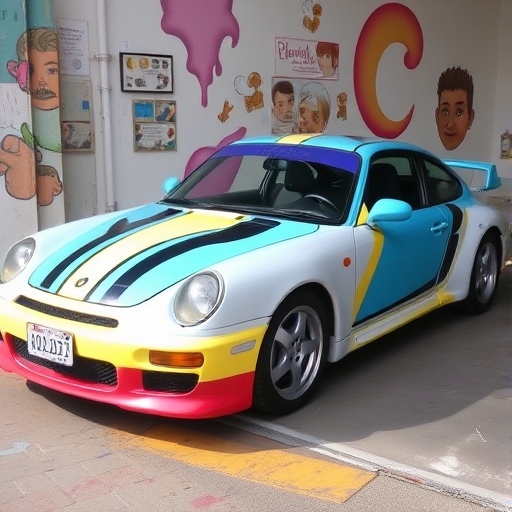Can I Paint My Own Car?
Painting your own car can be a rewarding project, giving you a sense of accomplishment and saving you money compared to hiring a professional. However, it’s not a task to be taken lightly. This article will guide you through the process of painting your own car, the tools you’ll need, common mistakes to avoid, and the pros and cons of DIY car painting.
Why Paint Your Own Car?
Painting your own car can be beneficial for several reasons:
- Cost Savings: Hiring a professional can cost hundreds to thousands of dollars, while DIY painting can be done for a fraction of the cost.
- Customization: You have complete control over the color, finish, and design of your car.
- Learning Experience: It’s a great way to learn about auto body work and improve your skills.
- Safety Gear: Respirator mask, goggles, gloves, and coveralls.
- Sanding Tools: Sandpaper (various grits), sanding block, and an electric sander.
- Cleaning Supplies: Degreaser, soap, and water.
- Paint Sprayer: HVLP (High Volume Low Pressure) spray gun or aerosol spray cans.
- Masking Tape and Paper: To protect areas you don’t want to paint.
- Paint Mixing Tools: Mixing cups and stir sticks.
- Automotive Primer: For preparing the surface.
- Automotive Paint: Choose a high-quality paint suitable for your car type.
- Clear Coat: For a glossy finish and added protection.
- Remove Masking Tape: Carefully remove the masking tape while the clear coat is still slightly tacky to avoid peeling.
- Polish: After the paint is fully cured, polish the surface to enhance the shine.
- Poor Preparation: Skipping cleaning or sanding can lead to a subpar finish.
- Wrong Paint Type: Always use automotive paint; household paint won’t adhere properly.
- Inadequate Ventilation: Ensure the area is well-ventilated to avoid inhaling fumes.
- Rushing the Process: Take your time with each step to ensure quality results.
Tools and Supplies Needed
Before you start the painting process, it’s essential to gather all the necessary tools and supplies. Here’s a comprehensive list:
Essential Tools
Paint and Primer
The Painting Process
Painting your car involves several steps, each crucial for achieving a professional-looking finish.
Step 1: Preparation
Preparation is key to a successful paint job. Follow these steps:
1. Choose a Suitable Location: A well-ventilated space away from dust and debris is ideal. A garage or outdoor area with a canopy can work well.
2. Clean the Car: Wash the car thoroughly with soap and water to remove dirt, grease, and grime.
3. Sand the Surface: Use sandpaper to sand down the entire car surface. This helps the primer and paint adhere better.
4. Mask Off Areas: Use masking tape and paper to protect windows, trim, and other areas you don’t want to paint.
Step 2: Priming
1. Apply Primer: Use an automotive primer to coat the sanded areas. This step is crucial for ensuring a smooth paint finish.
2. Sand the Primer: Once the primer is dry, lightly sand it with fine-grit sandpaper to create a smooth surface.
3. Clean Again: Wipe down the primed surfaces with a clean cloth to remove any dust.
Step 3: Painting
1. Mix the Paint: Follow the manufacturer’s instructions for mixing the paint, ensuring it’s the right consistency.
2. Test Spray: Before painting the car, do a test spray on a piece of cardboard to check the spray pattern and color.
3. Apply Base Coat: Start painting from the top and work your way down. Use even, overlapping strokes to avoid drips.
4. Let it Dry: Allow the paint to dry according to the manufacturer’s instructions.
Step 4: Clear Coat
1. Apply Clear Coat: Once the base coat is dry, apply a clear coat to protect the paint and give it a glossy finish.
2. Final Curing: Allow the clear coat to cure fully, following the recommended time.
Step 5: Finishing Touches
Common Mistakes to Avoid
While painting your own car can be a fun project, there are common pitfalls to avoid:
Pros and Cons of DIY Car Painting
| Pros | Cons |
|---|---|
| Cost-effective | Time-consuming |
| Customizable results | Requires skill and practice |
| Sense of accomplishment | Potential for mistakes and imperfections |
| Opportunity to learn new skills | Need for proper tools and equipment |
FAQ
1. How much does it cost to paint your own car?
The cost can vary widely based on the products you choose, but on average, you can expect to spend between $100 to $600 for the paint, primer, and necessary tools.
2. Is it legal to paint my own car?
Yes, it is legal to paint your own car, but be sure to follow local regulations regarding vehicle modifications and color changes.
3. How long does it take to paint a car?
The time it takes can vary based on your experience and the size of the car, but typically, a DIY paint job can take anywhere from a weekend to a few weeks if you include drying and curing times.
4. Can I paint over existing paint?
Yes, but it’s essential to sand the existing paint to create a rough surface for the new paint to adhere properly.
5. What type of paint should I use?
Always use automotive paint that is specifically designed for vehicles. Options include acrylic enamel, urethane, or acrylic lacquer.
Conclusion
Painting your own car can be a fulfilling project if you approach it with patience and preparation. By understanding the tools and techniques involved, you can achieve a professional-looking finish right in your garage. Whether you’re looking to refresh the look of your vehicle or customize it entirely, the DIY route offers a unique opportunity to express your personal style while saving money.
Remember to take your time, and don’t hesitate to ask for help or consult resources if you’re unsure about any step in the process. Happy painting!

